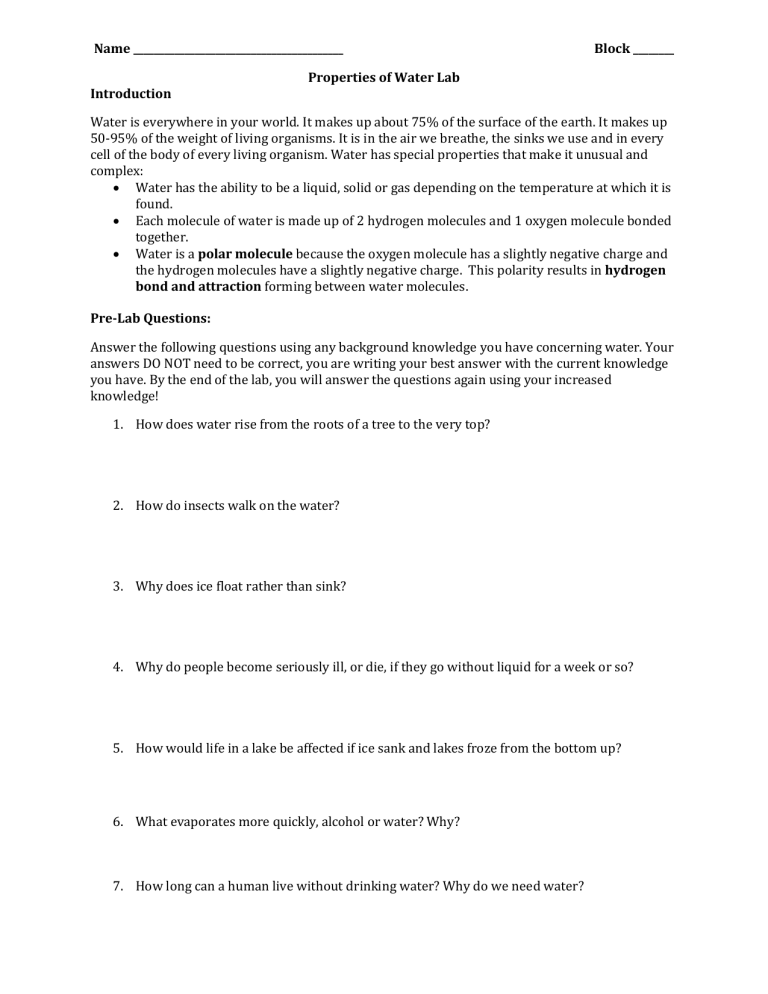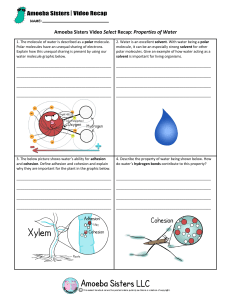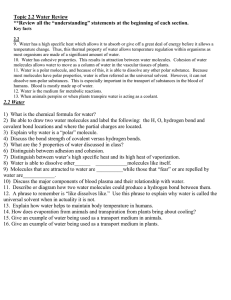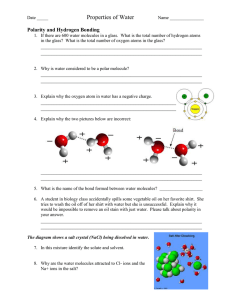
Name _________________________________________ Block ________ Properties of Water Lab Introduction Water is everywhere in your world. It makes up about 75% of the surface of the earth. It makes up 50-95% of the weight of living organisms. It is in the air we breathe, the sinks we use and in every cell of the body of every living organism. Water has special properties that make it unusual and complex: Water has the ability to be a liquid, solid or gas depending on the temperature at which it is found. Each molecule of water is made up of 2 hydrogen molecules and 1 oxygen molecule bonded together. Water is a polar molecule because the oxygen molecule has a slightly negative charge and the hydrogen molecules have a slightly negative charge. This polarity results in hydrogen bond and attraction forming between water molecules. Pre-Lab Questions: Answer the following questions using any background knowledge you have concerning water. Your answers DO NOT need to be correct, you are writing your best answer with the current knowledge you have. By the end of the lab, you will answer the questions again using your increased knowledge! 1. How does water rise from the roots of a tree to the very top? 2. How do insects walk on the water? 3. Why does ice float rather than sink? 4. Why do people become seriously ill, or die, if they go without liquid for a week or so? 5. How would life in a lake be affected if ice sank and lakes froze from the bottom up? 6. What evaporates more quickly, alcohol or water? Why? 7. How long can a human live without drinking water? Why do we need water? Property #1: Cohesion Water molecules are attracted to other water molecules like magnets. This attraction between individual molecules and their ability to stick together is called cohesion. Cohesion between water molecules exists due to the hydrogen bonds between molecules. Hydrogen bonds, are typically not considered true chemical bonds (like covalent and ionic bonds which occur in compounds to bond atoms or ions together), but they are strong intermolecular forces or attractions between molecules. Although strong enough to give water many of its properties, hydrogen bonds are still significantly weaker than ionic or covalent bonds. Pre-activity Question: How do hydrogen bonds differ from ionic and covalent bonds? Activity: How many water drops fit on a penny? 1. Predict how many drops you will be able to put on the penny before it overflows by having each person at your table guess and write the guesses below: Group Member #1: _______ Group Member #2: _______ Group Member #3: _______ 2. Drop water from the dropper onto the penny, keeping a careful count of each drop. As you are adding the drops, draw a diagram showing the shape of the water on the penny after one drop, when the penny is half full and just before it looks like it is going to overflow: After 1 drop: When penny is half full: Just before overflowing: Questions: 1. How many total drops did you get on the penny? __________________ 2. Explain your results in terms of cohesion. Be sure to explain the definition of cohesion in your answer. 3. Explain the concept of cohesion using an real-life analogy (similar to how magnets are mentioned above) Property #2 – Surface Tension Related to cohesion is surface tension, a measure of how difficult it is to stretch or break the surface of a liquid. Surface tension is also described as the tendency of a liquid to minimize surface area. Water has a particularly high surface tension due to the hydrogen bonds. Because the water molecules at the surface have water molecules pulling on them/attracting them from the bottom only, not the top, they pack very closely together. This close packing is what allows an insect to walk on water or you to skip a rock across a pond. In the previous activity, surface tension was evident in the dome shape of the water on the penny. The molecules formed a dome to minimize surface area. In this activity, you will compare your results from the previous activity to results of the same procedure using a penny coated with detergent. The addition of detergent will change the surface tension property of the water. Activity: 1. With your finger, spread one drop of detergent on the surface of a dry penny. 2. Predict how many drops you think this penny will hold after being smeared with detergent. Group Member #1: _______ Group Member #2: _______ Group Member #3: _______ 3. Drop water from the dropper onto the penny, keeping a careful count of each drop. As you are adding the drops, draw a diagram showing the shape of the water on the penny after one drop, when the penny is half full and just before it looks like it is going to overflow: After 1 drop: When penny is half full: Just before overflowing: 4. Did the detergent have an effect on the outcome? Explain your results compared to your results in the first activity. 5. How does the detergent affect the water? (Look back at the definition and cause of surface tension) What do you think the detergent affects? Property #3 – High Heat of Vaporization and Specific Heat Capacity Water has a high heat of vaporization - the energy required to convert liquid water to a gas. More energy is required for water to convert to the gas as compared to many other liquids due to the attraction/hydrogen bonds between the water molecules. For the water to become a gas, the hydrogen bonds need to be broken and the individual molecules need to be separated. Because of this property, water evaporates more slowly. Water also has a high specific heat capacity. Specific heat is a measure of heat capacity, is the heat required to raise the temperature of 1 gram of water 1°C. Water, with its high heat capacity, therefore, changes temperature more slowly than other compounds. Activity: 1. Simultaneously stick one cotton swab into a beaker of water while doing the same with a second cotton swab in a beaker of isopropyl alcohol. 2. Wipe an equal small amount of both water and alcohol on the back of your hand. Time how long it takes for each to evaporate. Repeat. Record data in the table below: Substance Trial 1 Time to Evaporate Trial 2 Time to Evaporate Questions: 1. Which substance evaporate more slowly and thus had the higher heat of vaporization? 2. Which substance thus stays a liquid longer and would be more resistant to temperature changes and store heat longer before turning to a gas? 3. Think about what happens when you boil water for pasta. Which becomes hot first, the pot or the water in the pot? 4. Read page 25, section 2.12, in your book and explain how these properties helps water to moderate temperature on both our planet and in living organisms. Property #4 - Universal Solvent Because of its high polarity and thus ability to attract ions and other polar substances, water is called the universal solvent. A solvent is a substance that dissolves, or breaks apart, another substance (known as a solute). A general rule that determines whether a substance will dissolve in a solvent depends upon its polarity. Polar solvents, like water, dissolve polar or ionic solutes and nonpolar solvents dissolve nonpolar solutes. Water’s ability to dissolve many solutes and as the main solvent found in living organisms, makes water’s property as a solvent vital to life. Activity To observe how water behaves as a solvent, you will attempt to dissolve a variety of substances in liquid water. To do so, measure 50 ml of deionized water into each of four 100 ml beakers and attempt to dissolve each substance by thoroughly stirring or swirling. Record the results in the data table, noting whether each substance is polar, non-polar or ionic: Beaker #1 – 0.5 grams of NaCl, also known as “table salt” (ionic) Beaker #2 – 0.5 grams of sucrose, also known as “table sugar” (polar) Beaker #3 – 1 squeeze from a transfer pipet of vegetable oil (non-polar) Substance Name Polar, Non-Polar or Ionic Did it dissolve in water? Questions: 1. Why is water called the universal solvent? 2. What types of substances dissolve in polar solvents like water? What types of substances do not dissolve in polar solvents? 3. Which substance(s) did not dissolve completely in water? Why? 4. Compare and contrast terms polar and non-polar. You may use notes from earlier in the unit. Property #5 – Density in solid water vs. liquid Density is a measure of the mass per unit volume of a substance, but can also be described by how compact or tightly packed the particles of a substance are in a given volume. Density increases if the number of particles in a given volume is higher and decreases if the number of particles in the same volume decreases. Thus, most solids are more dense than liquids of the same substance because the particles are more closely packed together. Read page 26, section 2.13 1. How is the density of liquid vs. solid water different than most substances? 2. Draw a particle diagram to show the difference between water at the solid, liquid and gas states. Gas is not shown in the book, but think about your previous knowledge of solids, liquids and gases to draw the diagram. 3. Why are the diagrams for water (between solid and liquid) different than what you would see for most substances? Explain using water’s chemical properties. 3. What happens when you place an ice cube in water? Does it sink or float? 4. Explain why this property is important to aquatic organisms. Why would they not survive if water did not have this property? Property #6 – Adhesion Adhesion is the ability for one substance to cling or attract to a different substance. This property is evident in water due the difference in charges within the individual molecules. Just as the positive end of a water molecule sticks to the negative end of a different water molecule (thus forming a hydrogen bond and cohesion between molecules), the positive ends and negative ends of the water molecules also stick or attract to positive and negative charges in other molecules of other substances. Glass molecules, in particular, are even more polar than water and thus water adheres to glass easily (think about the drops on a window). This property is how plants are able to exhibit capillary action and bring water up from their roots. Capillary action occurs when the adhesive properties of water are stronger than its cohesive properties and thus allows water molecules to flow up through a small tube, such as a stem, against gravity. 1. What is adhesion? 2. Describe what happens when you place a straw in a drink or raindrops fall on a window. 3. What is capillary action? How does it relate to adhesion? 4. What organism(s) depend on this property of water? Why? Summary 1. List three things that you discovered about water. 2. How do the characteristics of water help the body and our planet? 3. Review your answers to the questions from Station 1. Which property of water is represented by each question? Explain your answers. 1. 2. 3. 4. 5. 6. 7.







